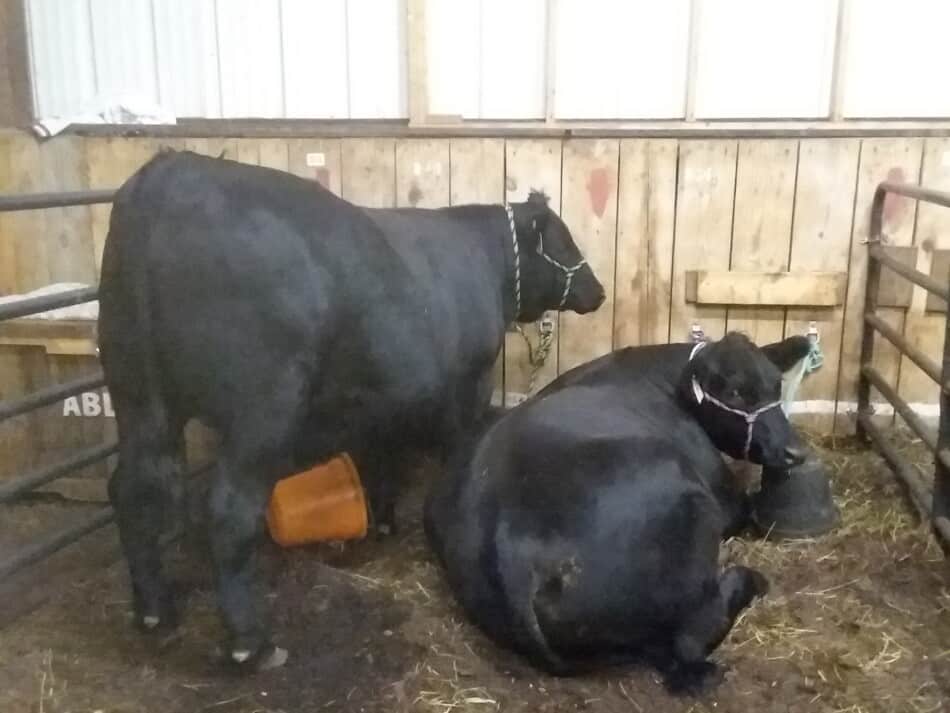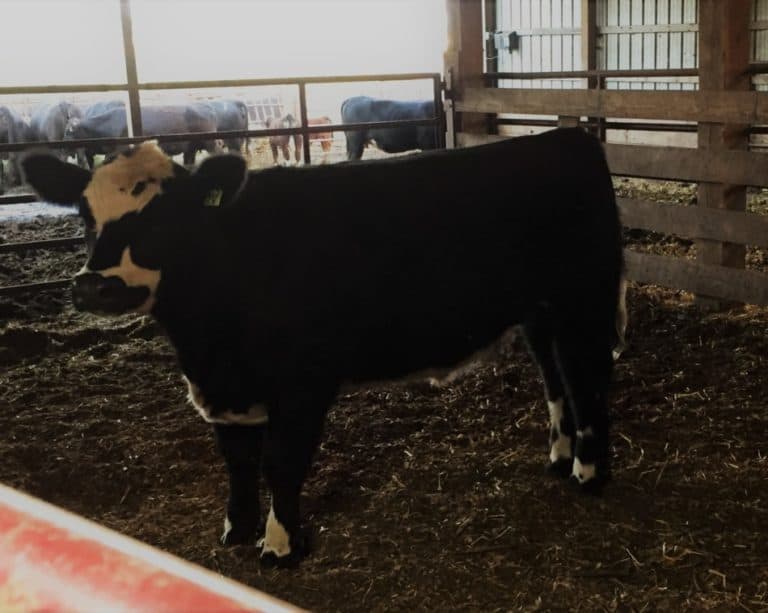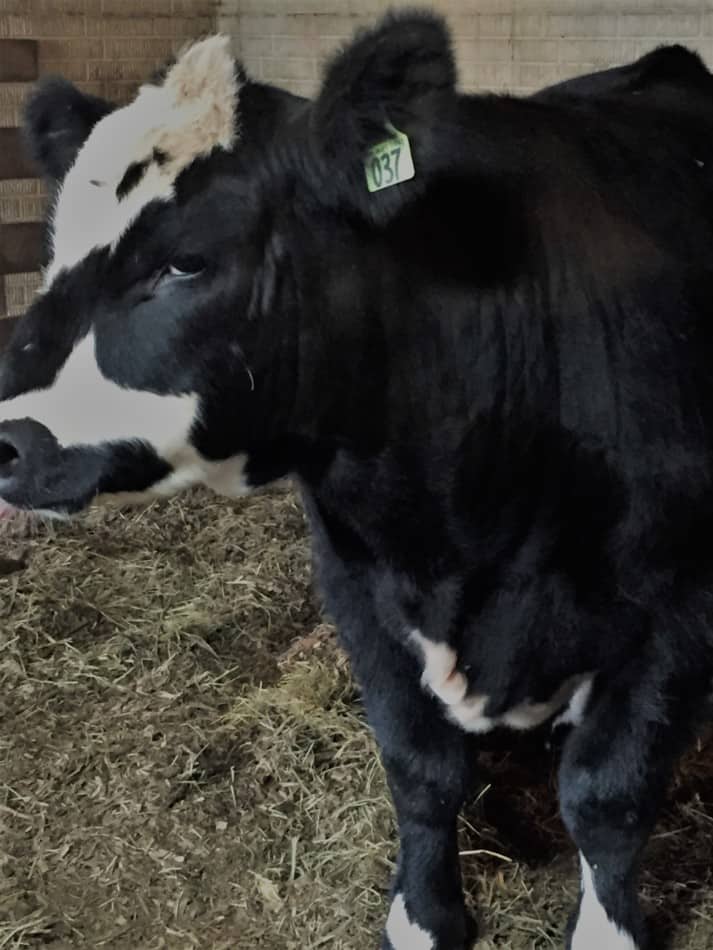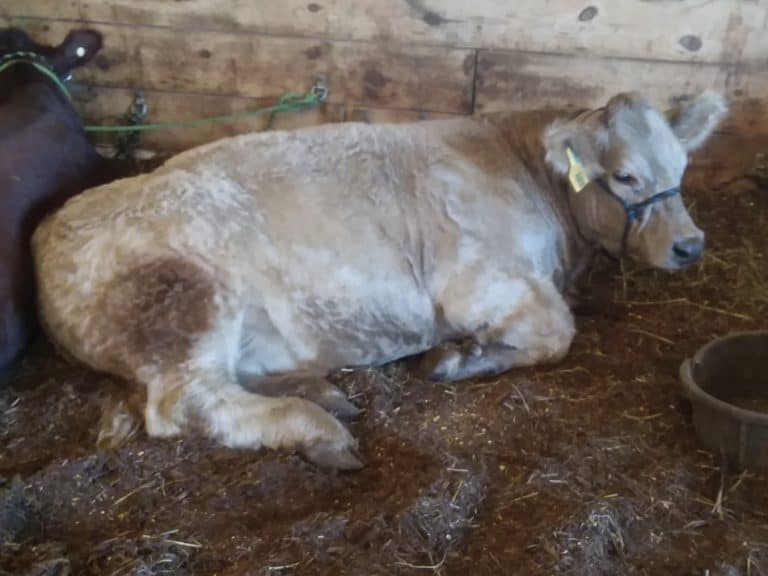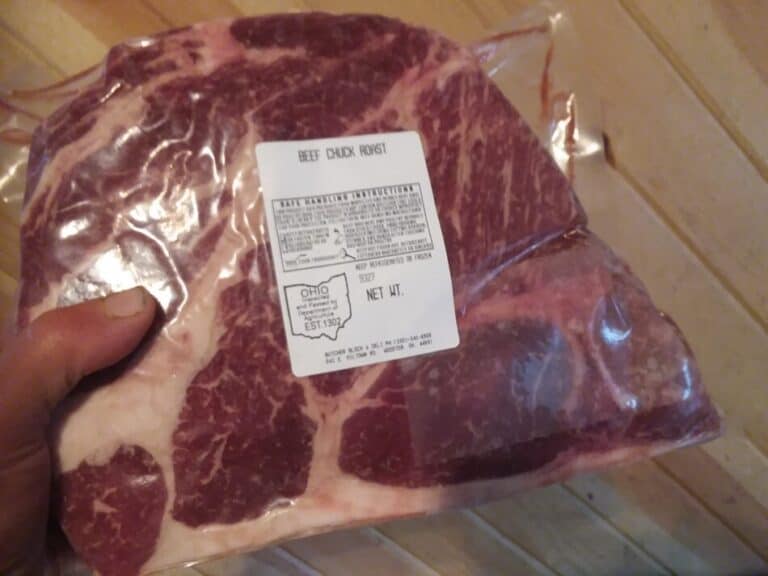14 Docile Beef Cattle Breeds: Good Choices For A Beginner

We love having cattle around our farm and nothing does a better job of turning your grass and other forages into meat than a bovine.
As a beginner, what breed of cattle should you choose for your farm? Let’s check it out!
The more docile beef breeds are Blonde d’Aquitaine, Beefmaster, British White, Devon, Galloway, Gelbvieh, Hereford, Lincoln Red, Maine Anjou, Murray Grey, Pinzgauer, Red Poll, Simmental, and South Devon.
You provide the land, water and shelter (which can be minimal) and the cattle work (graze and grow) on their own. Grazing cattle is a great use of your land and a happy life for your cattle.
Considering getting some cattle but are not sure if they are right for you? Should You Raise Cattle? will give you a list of 7 things you should have figured out before you decide to get cattle for your farm.
Is Raising Your Own Beef Worth It? goes over the numbers you need to know to figure up if raising your own beef will be worth it to you and your family.
Calm cattle are easier to work with
Occasionally though, you will need to get those gals inside a corral of some sort for a health check, periodic deworming or sorting off some of the herd to sell.
Maybe you see a cow calving and it looks like she could use some help or you just want a closer look at the baby.
These are all times when disposition of the cattle matters. It matters a lot.
So why not have cattle that are easier to handle and work around?
A big beautiful cow that freaks out when she sees you and runs through the barn wall (true story, it happened to my neighbor and the cow ended up here with ours for a few days) is going to be a tough gal to handle.
She may be a looker, but that’s definitely too feisty for me!

All cattle can get riled up and all cows will be leary of you being around her new calf-but does she try to flatten you or just keep close watch?
The calf’s disposition will be inherited from the cow
Another aspect to consider regarding cattle dispositions is that disposition is hereditary. A calm cow will have a calm calf.
Why not be populating your herd with cows you like to be around?
Good disposition is also very important for the health of your herd.
Calm cattle are going to grow better and stay healthier since stress negatively affects animals, just like stress negatively affects the health of people.
Calmer cattle use their feed more efficiently
Docile cattle more efficiently use their feed making them more economical to raise since they aren’t burning up energy while being fruity.
Attitudes are contagious, a few cows being nervous makes the rest of the herd edgy thinking that they should be nervous as well.
Finally a calmer cow is safer for you to be around. Cattle are big compared to people, even the small breeds handily outweigh you.
A beef cow can easily hurt you if she feels you are a threat. It only makes sense to start with an animal that will be easier to work with.
A few thoughts on containment-cattle push, sometimes a lot. An electric fence works well to keep them in.
If you are used to keeping smaller stock, like sheep, cattle will need more substantial gates and pens to keep them secure.
Usually this is because cattle are tall enough to reach over the shorter gate or non electric fencing and will smash it down when trying to reach something on the other side.
These animals are not being overly difficult, they are just being cattle.
Docile Beef Cattle Breeds
- Blonde d’Aquitaine
- Beefmaster
- British White
- Devon
- Galloway
- Gelbvieh
- Hereford
- Lincoln Red
- Maine Anjou
- Murray Grey
- Pinzgauer
- Red Poll
- Simmental
- South Devon
Blonde d’Aquitaine is a French breed
The Blonde d’Aquitaine is a cattle breed from the Garrone River region of France and is a combination of three lines of cattle all native to the area. The Blonde d’Aquitaine was imported to the U.S. in 1972.
Blondes are a larger breed with bulls weighing 2,600 pounds and cows averaging 1,700 pounds.
They are known for having a docile disposition, calving ease and heat tolerance.
Blondes color can range from nearly white to brown, but generally as the names suggests they are blonde.
The Beefmaster is originally from Texas
The Beefmaster is a common breed mostly found in the hot, dry regions of the U.S. Beefmasters were developed in Texas to give a higher yielding carcass on cattle with heat and insect resistance.
Tom Lasater was a rancher in Texas wanting more meat on his Brahman cattle.
The original cross he used in the 1930’s was 25% Hereford, 25% Shorthorn and 50% Brahman. This cross combines insect and heat resistance with good meat quality.
He chose six traits to breed for and completely ignored non commercial traits like color so the Beefmaster can be any color or pattern.
The six founding traits of the Beefmaster are 1. disposition, 2. fertility, 3. weight, 4. conformation, 5. hardiness, and 6. milk production (to ensure fast growing calves).
If you are in a hot area give Beefmaster a look as your breed of choice.
Unlike the rest of these breeds, Beefmaster is selected specifically for hardiness in heat.
British White are polled cattle
The British White cattle are originally from East Anglia, England. They are also called Polled White Park. The British White was imported to the U.S. in 1941 and again in 1976 and 1989. The breed society formed in 1976.
British Whites are known for being hardy, having good quality beef, and a gentle disposition. Bulls weigh 1,500 pounds and cows weigh 1,000 pounds.
The White Park cattle look very similar to the British White so be sure to look for polled (no horns) animals.
British White have an all white body with black points (like a Siamese cat) meaning the eyes, ears, nose, hooves and hair on the end of the tail are all black.
Devon cattle are a rare breed
The Devon is originally from the counties of Somerset and Devon in England. Other names for this breed are Beef Devon, North Devon, Red Devon and Red Ruby.
The Devon was also split into separate lines with the meatier stock used as beef and the cows with more dairy character used as a dual purpose cow, now called the Milking Devon.
The Devon bulls weigh 2,200 pounds and the cows weigh 1,100 pounds. Devons are known for being adaptable, early maturing, having a stocky frame and both cold and hot weather tolerance.
As you may have guessed from some of the alternative breed names these cattle are a beautiful ruby red color.
The Devon is also relatively difficult to find because it is a rare breed.
Galloway cattle are from Scotland
The Galloway is from Galloway, Scotland. The breed herdbook was started in 1862. The Galloway and Angus were initially kept together but split in into a separate breed society in 1878.
Galloways were imported to the U.S. shortly thereafter. with the U.S. herd book starting in 1882.
Galloway cattle started as a dual purpose breed (cattle kept for both meat and milk production). Now Galloways are kept only for beef.
Galloway cattle are known for hardiness, ease of management and great mothering ability.
Galloways come in solid colors ranging from brown to more of a dun. The winter hair coat is shaggy. It has two parts long hairs to shed rain and shorter hair for insulation.
Gelbvieh cattle are also called German Yellow
The Gelbvieh is from Bavaria, Germany and is also called the German Yellow.
Gelbvieh was created by mixing four main triple purpose cattle starting in 1856 in Germany. The breed was producing true and therefore able to start a registry 1897.
Gelbvieh is known for fast growth, feeding efficiency and having an even temperament. The name Gelbvieh is pronounced “gelp-fee” and simply means yellow cow in German.
The common color of Gelbvieh is yellow but can be any where from cream to reddish to black. These cows have a bit of a roman nose and have a very strong, muscular conformation.
Bulls weigh 2,500 pounds and cows weigh 1,600 pounds.
Hereford cattle originated in Herefordshire, England
The Hereford is from Herefordshire which is just outside of London, England. Herefords came to the U.S. in 1847.
This is a very popular breed that can be found nearly anywhere farmers are raising cattle.
Herefords can be polled or horned, with each breed kept in separate registration associations.
Herefords are red cattle with a white face, underside and tail switch (the switch is the long hair at the end of the tail).
These cattle should be a beautiful cherry red and not have any black hairs any where on the body.
Hereford’s are so popular because they are fast growers, docile, and produce good quality beef.
Since they are so wide spread throughout the world they are also easy to find making Hereford a great choice for a new beef cattle raiser.
Lincoln Red are a larger cattle breed
The Lincoln Red is from Lincolnshire, England. Originally a dual purpose breed they are now bred for beef production.
Lincoln Reds are as the name suggests always red in color, some with occasional small white specks on the underline.
Lincoln Red is the largest British beef breed with bulls weighing 2,000 pounds and cows averaging 1,500 pounds.
These cattle started off as part of the Shorthhorn breed but were separated off into their own breed in 1894.
They are known for the ability to thrive on less than great feed, fast maturity, easy calving, and having a high dressing percentage (more meat on the carcass and less bone). Lincoln Reds are docile.
Maine Anjou originated in France
The Maine Anjou originated in Brittany, France in the 1830’s. Durham, another name for Shorthorn, and Mancelle, a native Brittany breed, were crossed to produce a dual purpose breed suited to the area.
The Maine Anjou is a red and white breed that is the heaviest of all french breeds.
They are known for having a gentle disposition, good growth rate, frame sized (big bone structure) and feeding efficiency.
Maine Anjou bulls weigh 2,500 pounds and cows weigh 1,700 pounds.
Murray Grey are from Australia
The Murray Grey is a cattle breed from New South Wales, Australia. The Murray Grey started as an attractive cross of Angus and Shorthorn first selected for in 1905 with the breed society forming in 1963.
Murray Greys are known for high quality beef, early maturity, being docile and being good mothers.
These are stocky, low set cattle with bulls weighing 2,000 pounds and cows weighing 1,200 pounds.
As you may have guessed the color is grey, which can vary from light to dark and may have a few small white spots on the underside.
What you may not have guessed is the Murray Grey actually has black skin so the skin around the eyes and the end of the nose are black.
I have always preferred a black skinned cow, the dark pigment makes head look much more defined and attractive.
Pinzgauer cattle originated in the Austrian Alps
The Pinzgauer is from the Austrian Pinz Valley, which is in the Alps. The Pinzgauer is a friendly breed that adapts well to many areas.
Pinzgauer bulls normally weigh 2,500 pounds and cows average 1,500 pounds.
They are a chestnut brown color on the sides with white on the top line from the shoulders back to the end of the tail. The underside is also white.
Red Poll cattle are from England
The Red Poll is from the Norfolk and Suffolk counties of England. As the name suggestests these cattle are always a red shade from light to dark but always red and always polled (naturally do not grow horns).
The Red Poll is known for hardiness, maternal ability, lean beef and having one of the longest lifespans of all the British breeds.
Red Polls were imported to the U.S. in 1873.
Red Poll for those who are interested would make a great homesteading type cow because of it being easy to get along with and a non picky eater. They also give a decent amount of milk.
Simmental cattle are from Switzerland
The Simmental is originally from Switzerland and has many names depending upon the country including Fleckvieh (Germany), and Pie Rouge, Montbeliard, and Abondance (France).
Simmentals were a triple purpose breed meaning they were developed and used for meat, milk and draft. This breed was officially recognized in 1862.
Now most people raising Simmentals raise them for meat. Their partial dairy heritage makes them better milkers so the calves will be able to grow faster.
Simmentals are currently the third most popular beef breed in the U.S.
The main characteristics of a good Simmental are good mothering, a docile disposition, good beef quality and being a hardy animal.
Simmentals can come in any color there is no color specification at all. Most of the stock I see is black, especially if you are using Artificial Insemination, all the current bulls available are black.
I always like the blonde body color with the white face-that is a beautiful cow!
South Devon are dark red cattle
The South Devon is a separate breed from the Devon mentioned above. South Devons are originally from South Hams, near Devon, England.
They are known for being docile, having a long lifespan and being resistant to heat and insects.
The South Devon were mainly kept on small farms as a dual purpose breed providing milk and oxen for draft power.
The South Devon is a brownish red color. This is an easy way to distinguish it from the Devon and the Sussex, both of which are similar looking cattle breeds but Devons have a much darker red coat.
Crossbred cattle may be a better choice for beginners
I know this is an article about cattle breeds, but please consider getting some crossbred cattle for your starter herd, if there are some in your area that you like and are based on some of the breeds listed above.
Crossbred cattle will not be registered breeding stock, if that is a concern of yours, but are likely to be a bit more beginner friendly, as in bounce back from your mistakes, than a purebred individual.
Smaller cattle will be more efficient to feed
Here is something you may not be running across in your information search, small framed cattle are more efficient to feed. By small framed, I mean shorter at the hip, yet still very wide in bulls and feminine in cows.
By “more efficient to feed” I mean they gain weight on less feed. The feed is whatever you give them, grass or hay, it doesn’t matter. (This has nothing to do with grain feeding.)
Look up some talks by Johann Zeitsman of Southern Africa or Jim Elizondo of Real Wealth Ranching.
They both give excellent information on they body type of cattle you should be selecting with plenty of pictures showing small framed, great looking cattle that are making their owners money on grass.
The reason I’m giving you these two sites to start your search with is that most of the information you’ll find on raising cattle focuses on bigger cattle, bigger cattle.
Those bigger cattle will finish at a higher weight, but they’ll do it much later and at a much higher cost to you! Since your biggest expense with raising cattle is feed, why not start out with cattle that grow more for the feed you provide?
Read Pharo Cattle Company information and insights
Consider looking into Pharo Cattle Company genetics. Check out their website and click around to see what they believe in and what they have to offer. If I were looking to get started in cattle, I’d start here.
Pharo offers articles, podcasts, great bull information and multiple YouTube videos. Seriously, spend some time reading over this site and think about how you could set up your herd to benefit you, your land and your herd the most.
Resources:
A Field Guide To Cows by John Pukite; and the Beef Checkoff website
Related Questions
Which breed of beef cattle is best?
The best breed of beef cattle is the breed that suits your area and the way you want to manage your herd.
There is no such thing as the one perfect breed. All breeds have advantages and disadvantages.
What are the most common beef cattle breeds?
The most common beef cattle breeds in the U.S. are Angus, Charolais, Hereford, and Simmental.
